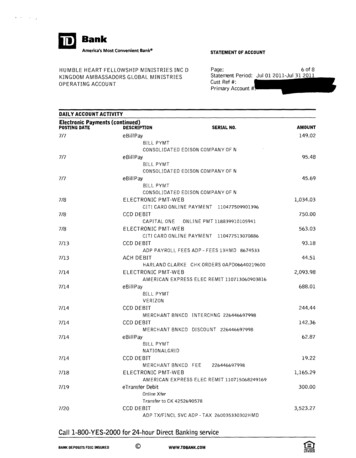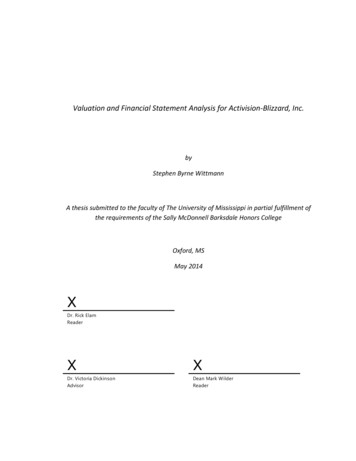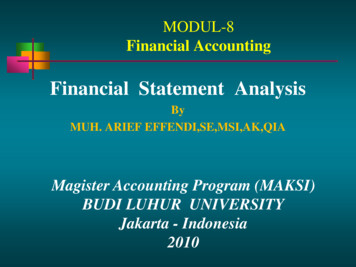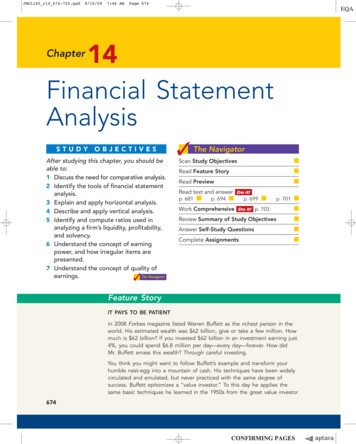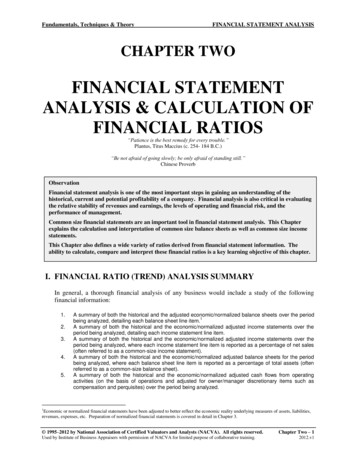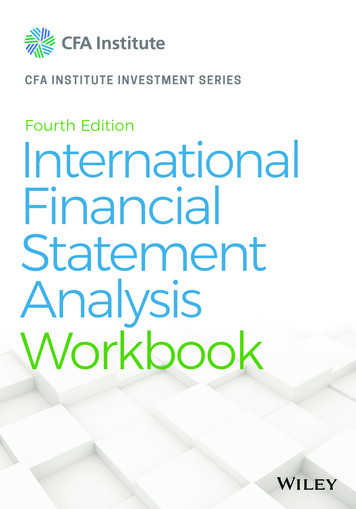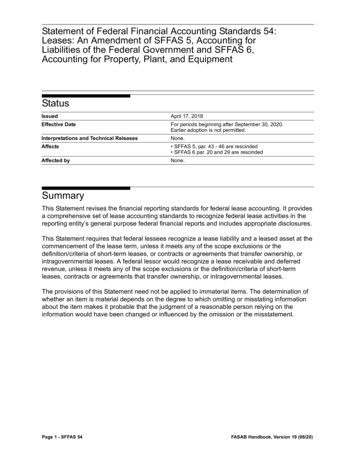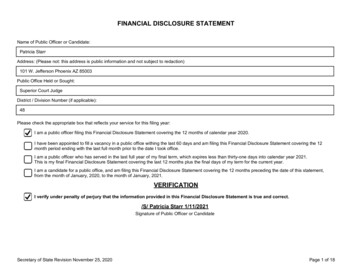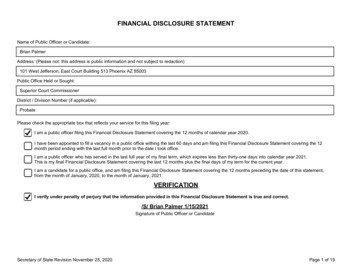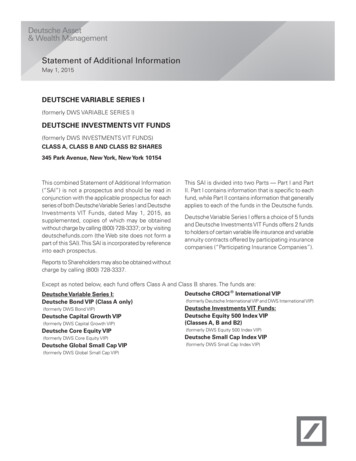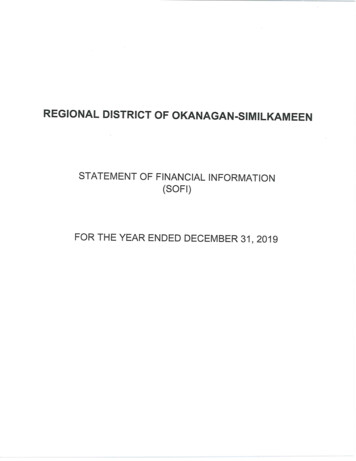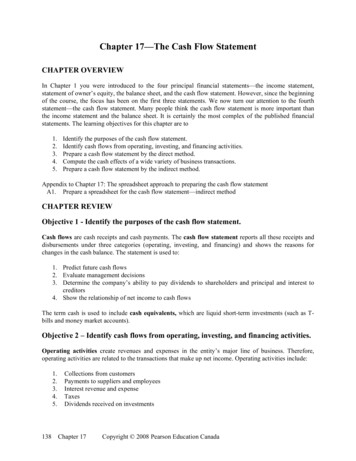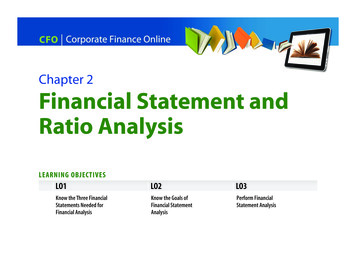
Transcription
M02 MCNA8932 01 SE C02.indd Page 2-1 25/10/13 7:42 PM f-w-155/204/PHC00100/9780132758932 MCNALLY/MCNALLY CORPORATE FINANCE ONLINE CFO01C SE 9Chapter 2Financial Statement andRatio AnalysisLEARNING OBJECTIVES LO1Know the hree FinancialStatements Needed forFinancial Analysis LO2Know the Goals ofFinancial StatementAnalysis LO3Perform FinancialStatement Analysis
M02 MCNA8932 01 SE C02.indd Page 2-2 25/10/13 7:42 PM f-w-155Financial Statement and Ratio Analysis/204/PHC00100/9780132758932 MCNALLY/MCNALLY CORPORATE FINANCE ONLINE CFO01C SE 9IntroductionIntroductionEarlier, we learned that the goal of the financial manager is to maximize shareholderwealth, which occurs when the firm’s share price is maximized. In this chapter, we wantto get more pragmatic. How does the financial manager know that he or she is movingthe company in the right direction, and how do investors in the firm’s shares evaluate theperformance of the managers? The stakeholders look at the firm’s financial statements foranswers to these and other questions. Firm managers use accounting information to helpthem manage the firm. Investors and creditors use accounting information to evaluatethe firm.This chapter focuses on the interpretation and analysis of financial statements. To performfinancial analysis, you will need to know how to use common-sized financial statements,financial ratios, and the Du Pont ratio method. In addition, you will learn market-basedratios that provide insight about what the market for shares and bonds believes aboutfuture prospects of the firm.Financial analysis is the process of using financial information to assist in investmentand financial decision making. Financial analysis helps managers with efficiency analysis and identification of problem areas within the firm. Also, it helps managers identifystrengths on which the firm should build. Externally, financial analysis is useful for creditmanagers evaluating loan requests and investors considering security purchases.
M02 MCNA8932 01 SE C02.indd Page 2-3 25/10/13 7:42 PM f-w-155Financial Statement and Ratio AnalysisLO1/204/PHC00100/9780132758932 MCNALLY/MCNALLY CORPORATE FINANCE ONLINE CFO01C SE 9LO1 The Financial Statements1.1 The Balance SheetThe Financial StatementsThree financial statements are critical to financial statement analysis: the balance sheet, theincome statement, and the statement of cash flows. We provide a brief overview of eachstatement and describe what information it contains.1.1 The Balance SheetThe balance sheet provides the details of the accounting identity.Assets Liabilities Owners equityorInvestments Investments paid for with debt Investments paid for with equityThe balance sheet is a financial snapshot of the firm, usually prepared at the end of thefiscal year. That is, it provides information about the condition of the firm at one particularpoint in time. By reviewing a series of balance sheets from different years, the analyst canidentify changes in the firm over time. Table 2.1 shows a sample balance sheet, and thevideo discusses its content.
M02 MCNA8932 01 SE C02.indd Page 2-4 25/10/13 7:43 PM f-w-155Financial Statement and Ratio Analysis/204/PHC00100/9780132758932 MCNALLY/MCNALLY CORPORATE FINANCE ONLINE CFO01C SE 9LO1 The Financial Statements1.1 The Balance SheetTable 2.1 Sample Balance SheetAssetsLiabilities and EquityCurrent AssetsCashMarketable securitiesAccounts receivableInventoriesTotal current assetsCurrent LiabilitiesAccounts payableAccrued expensesShort-term notesFixed AssetsLong-Term LiabilitiesMachinery and equipmentBuildingsLandLong-term notesMortgagesTotal fixed assetsTotal current liabilitiesTotal long-term liabilitiesOther AssetsEquityInvestmentsPatentsPreferred sharesCommon sharesPar valuePaid in capitalRetained earningsTotal equityTotal other assetsTotal AssetsTotal Liabilities and Equity
M02 MCNA8932 01 SE C02.indd Page 2-5 25/10/13 7:43 PM f-w-155Financial Statement and Ratio AnalysisLO1 The Financial Statements/204/PHC00100/9780132758932 MCNALLY/MCNALLY CORPORATE FINANCE ONLINE CFO01C SE 91.2 The Income StatementIt is important to note that assets are owned only for the income they can produce for thefirm. Liabilities and owners’ equity provide the funds for the purchase of these assets.1. Assets generate income (the left-hand side)The left-hand side of the balance sheet lists the firm’s assets. The only reason for a firmto hold an asset is if it produces income. The assets of the firm produce the firm’sincome. There is no reason for a firm to hold an asset if it is not going to produce income.2. Financing the assets (the right-hand side)For every dollar in assets the firm has, there will either be a dollar of liability or a dollarof equity on the right-hand side of the balance sheet. The right-hand side of the balancesheet shows how the firm is financing its assets. By adjusting the mix of debt and equity,the lowest cost of financing can be achieved.In summary, the left-hand side of the balance sheet reports the assets that earn income andthe right-hand side reports how these assets are financed.1.2 The Income StatementUnlike the balance sheet, which tells us the state of the firm at one point in time, the incomestatement tells us how the firm has performed over a period of time.
M02 MCNA8932 01 SE C02.indd Page 2-6 25/10/13 7:43 PM f-w-155Financial Statement and Ratio AnalysisLO1 The Financial Statements/204/PHC00100/9780132758932 MCNALLY/MCNALLY CORPORATE FINANCE ONLINE CFO01C SE 91.2 The Income StatementIncome statements usually have two sections. The first section reports the results of operating activities or operating income. This includes sales minus operating expenses. Financingactivities are reported in the second section, where interest expense, taxes, and preferreddividends are subtracted to arrive at net income. Table 2.2 provides a sample income statement, and the video discusses the content of the income statement.Table 2.2 Sample Income StatementSales- Cost of goods soldGross ProfitOperating Activities- Selling expense- Administrative expense- Depreciation expenseEarnings Before Interest and Taxes (EBIT)- Interest expenseEarnings Before TaxesFinancing Activities- TaxesNet Income Before Preferred Dividends- Preferred share dividendsNet Income Available to Common Shareholders
M02 MCNA8932 01 SE C02.indd Page 2-7 25/10/13 7:43 PM f-w-155Financial Statement and Ratio AnalysisLO1 The Financial Statements/204/PHC00100/9780132758932 MCNALLY/MCNALLY CORPORATE FINANCE ONLINE CFO01C SE 91.3 Statement of Cash Flows1.3 Statement of Cash FlowsMany students are not as comfortable with the statement of cash flows as they are with theincome statement and balance sheet. It does, however, provide insight not readily availablefrom the other statements. In finance, we are particularly concerned with cash flows ratherthan accounting earnings. Table 2.3 shows a sample statement of cash flows. The Explain Itvideo explains the content of the statement of cash flows.
M02 MCNA8932 01 SE C02.indd Page 2-8 25/10/13 7:43 PM f-w-155Financial Statement and Ratio Analysis/204/PHC00100/9780132758932 MCNALLY/MCNALLY CORPORATE FINANCE ONLINE CFO01C SE 9LO1 The Financial Statements1.3 Statement of Cash FlowsTable 2.3 Sample Statement of Cash FlowsCash Flow from OperationsNet profit after taxes Depreciation Decrease in accounts receivable Decrease in inventories Increase in accounts payable Decrease in accrualsCash provided by operationsCash Flow from InvestmentsIncrease in fixed assetsChange in business ownershipCash provided by investment activitiesCash Flow from Financing Activities Decrease in notes payable Increase in long-term debt Changes in shareholders’ equity- Dividends paidCash provided by financing activitiesNet increase/decrease in cash and marketable securities
M02 MCNA8932 01 SE C02.indd Page 2-9 25/10/13 7:43 PM f-w-155Financial Statement and Ratio Analysis/204/PHC00100/9780132758932 MCNALLY/MCNALLY CORPORATE FINANCE ONLINE CFO01C SE 9LO1 The Financial StatementsSTOPReady to doLO1topic homework 1?MyFinanceLab
M02 MCNA8932 01 SE C02.indd Page 2-10 25/10/13 7:43 PM f-w-155Financial Statement and Ratio AnalysisLO2/204/PHC00100/9780132758932 MCNALLY/MCNALLY CORPORATE FINANCE ONLINE CFO01C SE 9LO2 The Goals of Financial AnalysisThe Goals of Financial AnalysisExactly what can we hope to accomplish by analyzing the financial aspects of a firm?Financial analysis is a powerful tool to help drive investment and management decisions.However, we will not find many absolute answers. What we may find is a number of redflags that help focus our attention.Outsiders will conduct financial analysis differently than managers, also referred to asinsiders. Clearly, insiders have access to information unavailable to others in the market.This gives them an advantage when ratios raise questions. For example, suppose a firmdiscovers it has a falling profit margin. It has also found that its inventory is not sellingas quickly as in the past. Insiders can order an analysis to determine which specific itemsare not moving well. Outsiders may only speculate about the quality of the inventory mix.However, both insiders and outsiders have a common goal of attempting to identify thestrengths and weaknesses of the firm.Identify Company WeaknessesOne goal of financial analysis is to identify problems that affect the firm. By identifying problems early, managers can make corrections to improve firm performance. Someproblems may be hard to identify. A firm that seems to be earning profits but is constantlyshort of cash may turn to financial analysis to identify why this is occurring.
M02 MCNA8932 01 SE C02.indd Page 2-11 25/10/13 7:43 PM f-w-155Financial Statement and Ratio Analysis/204/PHC00100/9780132758932 MCNALLY/MCNALLY CORPORATE FINANCE ONLINE CFO01C SE 9LO2 The Goals of Financial AnalysisInvestors are also interested in identifying companies with problems as early as possible.No one wants to stay on a sinking ship any longer than necessary. Analysts hope they canidentify firms with problems before other investors so they can sell their shares before theprice drops.Identify Company StrengthsAnother equally important purpose of financial analysis is to identify company strengths sothose strengths can be enhanced and used to their greatest potential. For example, in theearly 1970s, falling inventory turnover ratios and return on equity ratios told JCPenney thatit was not able to compete successfully with high volume discount stores; however, it wasable to sell good quality clothing. This discovery led to a major refocusing of the firm thatinvolved discontinuing its automotive, appliance, and furniture departments and up-scalingits clothing lines. Because of these changes, it succeeded where many of its competitorsfailed.
M02 MCNA8932 01 SE C02.indd Page 2-12 25/10/13 7:43 PM f-w-155Financial Statement and Ratio Analysis/204/PHC00100/9780132758932 MCNALLY/MCNALLY CORPORATE FINANCE ONLINE CFO01C SE 9LO2 The Goals of Financial AnalysisSTOPReady to doLO2topic homework 1?MyFinanceLab
M02 MCNA8932 01 SE C02.indd Page 2-13 25/10/13 7:43 PM f-w-155Financial Statement and Ratio AnalysisLO3/204/PHC00100/9780132758932 MCNALLY/MCNALLY CORPORATE FINANCE ONLINE CFO01C SE 9LO3 Financial Statement AnalysisFinancial Statement AnalysisIn this section, we introduce and briefly discuss a number of the more common financialratios. This is not an exhaustive list by any standard. There are many ratios that can be used.In fact, it is common for analysts to create specialized ratios to look at a factor peculiar to afirm or industry. For example, revenues and costs per kilometre flown are often computedfor airlines.The formulas presented here for each ratio may differ from those reported elsewhere. Aneffort has been made within this section to locate the most common definition for eachformula, but for some there is simply no consensus among reporting agencies. This meansthat, when you compare ratios computed by different sources, you must be sure they are allcomputed in the same way.Cross-Sectional AnalysisMost financial ratios mean little when viewed in isolation. For example, an inventory turnover ratio tells us how many times per year the company’s inventory is sold (we discuss thisratio later in the chapter). A value of 20 is not interesting until we learn that other firms inthe industry have an inventory turnover ratio of 3. Similarly, gross profit margins, liquidityratios, and activity ratios all vary substantially depending on the industry. Clearly, a grocerystore will turn over its inventory more frequently than an auto dealer will.
M02 MCNA8932 01 SE C02.indd Page 2-14 25/10/13 7:43 PM f-w-155Financial Statement and Ratio Analysis/204/PHC00100/9780132758932 MCNALLY/MCNALLY CORPORATE FINANCE ONLINE CFO01C SE 9LO3 Financial Statement AnalysisCross-sectional analysis is the comparison of one firm to other similar firms. A cross-sectionof an industry is used as a comparison for the firm’s numbers. There are a variety of sourcesof cross-sectional information. Value Line, Risk Management Association, and Mergent allpublish industry average ratio statistics. One way to identify a firm’s industry is by itsStandard Industrial Classification (SIC) code. SIC codes are four-digit codes given to firmsby the government for statistical reporting purposes.Many firms do not have any clear industry to use for comparison, such as conglomeratesthat do business in dozens of different industries. There are no good guidelines for pickingcomparison numbers for these types of firms. In other cases, the firm under study so dominates the industry that the industry ratios are simply mirroring that firm. Consider GeneralMotors (GM). With so few firms in the auto manufacturing business, what happens to GMhappens to the industry.One solution to the problem of finding good comparison numbers is to create your own listof competitors. Compare the
answers to these and other questions. Firm managers use accounting information to help them manage the fi rm. Investors and creditors use accounting information to evaluate the fi rm. This chapter focuses on the interpretation and analysis of fi nancial statements. To perform fi nancial analysis, you will need to know how to use common-sized fi nancial statements, fi nancial ratios, and .File Size: 2MBPage Count: 40
